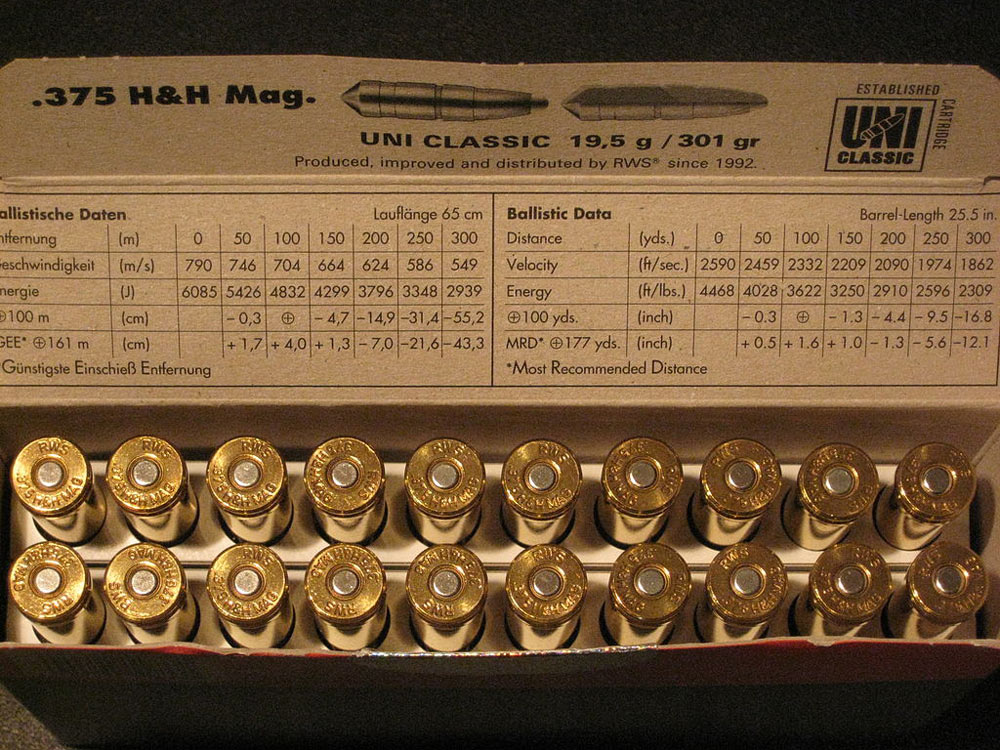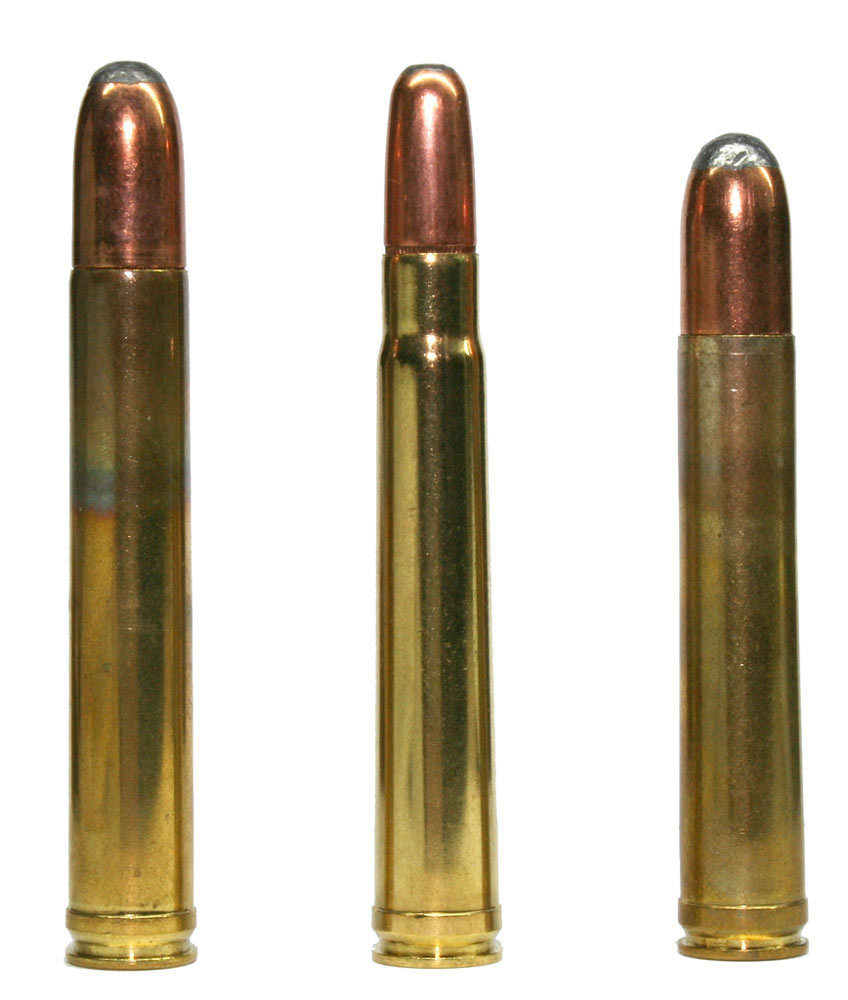

The .375 Belted Rimless Nitro Express, better known these days as the .375 H&H Magnum, is a medium-bore cartridge developed by the renowned British firm of Holland & Holland in 1912 as a one-upmanship on the Teutonic 9.3×62 cartridge, introduced some seven years earlier.
During the early twentieth century and earlier, many of the European powers were in expansive moods. Africa was one of their major expansion targets to increase their empires. Great Britain, along with Belgium, France, the Netherlands, Portugal, Germany and perhaps another or two, were busy carving out territories there.
One thing these early colonists learned early on was the critters they encountered in Africa were nothing like those inhabiting the hedgerows of Europe and the UK. Africa's wildlife had many species with the will and capability of biting back in spades. There was an ever-increasing demand for affordable rifles and ammunition capable of dealing with these animals.
The London and Birmingham gun trade in the UK supplied many such arms and ammo, but the English-built rifles could hardly be considered affordable by the settling farmers. The majority of the British large bore rifles capable of taking on the dangerous game of Africa at the time, were expensive double rifles, with a few single-shot rifles thrown in for good measure.
They were, by and large, superb quality rifles, mostly hand-made, and they and their ammunition were expensive. Otto Bock, a German gun maker, threw a monkey wrench into the English knickers when he introduced the 9.3×62 cartridge in 1905, and chambered many Mauser 98 rifles for this capable round.
The combination of the dangerous game capable cartridge, chambered in the comparatively inexpensive Mauser 98 rifle, was an immediate hit. Shortly after its introduction, most of the British manufacturers set about coming up with their own designs to compete with the Teutonic marvel, including Holland & Holland.
H&H chose a design that featured a rather long case with a long, slow taper. Since the shoulder was pretty small, H&H used a belted case for better headspace control, only the second cartridge to do so.
The powder used at the time was cordite, which consisted of long strands of propellent, rather than granules. The long slow tapered case facilitated the loading process, and contributed to almost fool-proof feeding and extraction, a big advantage, particularly in tropical climates.
The downside is that the cartridge length required a longer length action. It is possible, with substantial machining, to fit the cartridge in a standard length Model 98 Mauser action, but generally it is not a good idea.
If a world-wide hunter wanted to hunt anything on the planet with but a single rifle, the .375 H&H is one of, if not the best all-around choice. Commercially loaded ammunition is available just about everywhere, and practically every hunting camp in Africa has at least a box or two around.
It is loaded in primarily two bullet weights, 270 and 300 grains. In the past it was also available in a bullet weight of 235 grains, but I've not seen any in decades. I'm not sure it is even loaded in the bullet weight anymore, but that doesn't matter. The two bullet weights that are readily available everywhere cover the planet nicely.
Jack O'Connor was a great admirer of the cartridge, and used it extensively, mostly on the big cats, lions and tigers. John “Pondoro” Taylor, author of the bible on African Rifles & Cartridges and so titled, raconteur, avid hunter, and highly successful elephant poacher, also thought very highly of the cartridge.

He wrote that one of his rifles in that chambering had accounted for more than 100 elephant and some 411 buffalo, besides rhino, lions and lesser game. He also wrote, “Altho my formula gives this rifle a Knock-Out value of 40 points, I must regretfully admit that does not really do full justice to it. In actual practice the stopping power of the .375 Magnum would seem to warrant a higher classification.”
Originally a proprietary cartridge loaded exclusively for H&H, they released it to the trade after WWI, and it eventually made its way to the USA. Winchester apparently saw some marketing promise and began manufacturing rifles chambered for it in 1925.
It became quite popular for American safari hunters and also brown bear guides in Alaska, and still is. I currently have three rifles chambered for this magnificent cartridge, and will never be without at least one in my battery.
Actually, largely due to the vast improvements in bullet design and construction, it is a more efficient cartridge today than it has ever been. But then, so are all the rest of today's cartridges.

Next Step: Get your FREE Printable Target Pack
Enhance your shooting precision with our 62 MOA Targets, perfect for rifles and handguns. Crafted in collaboration with Storm Tactical for accuracy and versatility.
Subscribe to the Gun Digest email newsletter and get your downloadable target pack sent straight to your inbox. Stay updated with the latest firearms info in the industry.

![Best Concealed Carry Guns In 2025 [Field Tested] Wilson Combat EDC X9S 1](https://gundigest.com/wp-content/uploads/Wilson-Combat-EDC-X9S-1-324x160.jpg)


![Best 9mm Carbine: Affordable PCCs [Tested] Ruger Carbine Shooting](https://gundigest.com/wp-content/uploads/Ruger-Carbine-Shooting-100x70.jpg)
![Best AR-15: Top Options Available Today [Field Tested] Harrington and Richardson PSA XM177E2 feature](https://gundigest.com/wp-content/uploads/Harrington-and-Richardson-PSA-XM177E2-feature-100x70.jpg)

“Anything under 40 caliber is a cap gun”
I’ve taken everything from deer and antelope to cape buffalo and hippo on land with my cap gun.
What are you Bear? Maybe 13 years old. What have you hunted with the 375 H&H magnum?
Silly little boy.
I like 416 rem mag.
Anything under 40 caliber is a cap gun!